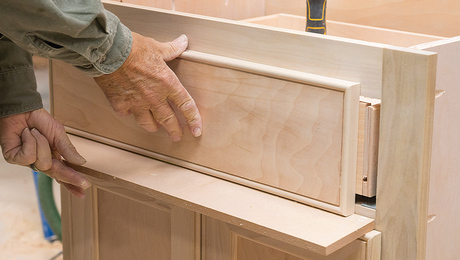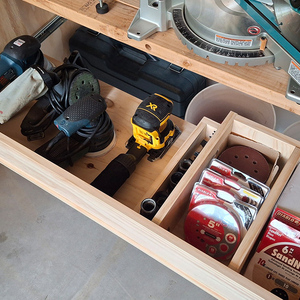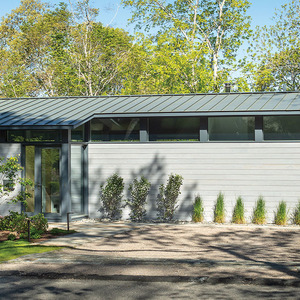Maximum recommended length of conduit run
This seems like a novice question, but I have never had an occasion to install such a long conduit run before.
I need to run 400 feet of PVC conduit to hold three 3/0 and one #4 copper THHN conductors. These will fit in a 2″ conduit, but …
Those of you with long run experience, would you go to a larger conduit, and, or break the run into smaller pulls.
Thanks,
Frank DuVal



















Replies
Both.
If you can, put a pull box mid-run. And use 2 1/2" pipe.
One other suggestion: at the ends of the 400 foot run, use heavywall steel sweep elbows to go from vertical to horizontal. Even with lots of yellow 66, the heat from the pressure of pulling 200 feet or more can cut right into the PVC sweeps. Thta's not fun at all--the pull seems to be going OK, then you stop for something, and everything freezes up solid.
No NEC requirement to ground the elbows if they're deeper than 18" at highest point.
If the conduit is in place and it's all sched 40, use lots of yellow 66 and keep the pulling speed down, even if the pulling is easy.
Good luck.
Cliff
Finished!
Cliff,
Thanks, it pulled great.
I followed your recomendations and set a pull box about halfway in the forest. Used EMT elbows there, as the supply house did not have rigid 2 1/2" elbows. House end went straight through basement wall into the side of the C-H panel, no elbow. Shop end was already buried PVC elbow under slab. So we pulled from the middle to keep the high friction on the metal elbows. I used LOTS of that clear pulling lube, by the handfull. Went through 1/2 the 5 gallon pail.
I had a contractor with a mini excavator do the trenching through the forest and he used the mini excavator to pull the wire. He was there for other work also. Nice and slow with hydraulics and stopping every 15 feet or so to reset the rope on the bucket.
Thanks for all the help. Power is ON!
I'm thinking that an equally important question is whether you ought to be concerned with voltage line loss with conductors that long.
Yep, the wire should be appropriately upsized/derated. I'm sure there's a chart laying around somewhere.
Based on 240 volts the max current at 400' to maintain <3% V/D is around 120 amps for 3/0
Implies large commercial bldg with likely 480V 3 phase service (or higher)
Use smaller wire and distribution xfmr at the load end.
Poor design of whoever specified 400 ft of 3/0.
Is this a feeder or service conductors? It sounds more like a single phase feeder to me.
>>>Poor design of whoever
>>>Poor design of whoever specified 400 ft of 3/0.
Not only that, 400 ft of 3/0 copper must be worth a king's ransom these days.
Good replies, thank you.
It is a 125 amp feeder to my own garage. The garage is about 350 feet from my house. The house is 200+ feet from the power company's pad mount distribution transformer. The power company priced placing a meter base on the garage at $15,000 due to my low projected use. To them it is 600 feet of underground primary (34.5 kv [19.9 kv L-N]) and a pad mount transformer that will only ever feed my garage meter.
I picked 3/0 due to voltage drop.
I calculated the cost of operating two transformers 24 hours a day for a month and came to $40.00. Maybe that is a little high, but they consume some loss when humming. At best I could just drop the wire size to #3, as 480 volt would be the highest I would want to install. A seperate meter would also have a small monthly payment even if no kwh were used.
So the $3000+ in copper sound cheaper! Well, at least until an underground fault and I need to replace it!
No, I do not look forward to this job, But tools need electricity.
>>>So the $3000+ in copper
>>>So the $3000+ in copper sound cheaper
Ouch, that stings.
Don't know if it will be any cheaper, but have you considered Teck?
It sounds like you did your homework. You could certainly bump this up to 480v and back down to save on copper but you may not really end up saving that much money and you add to the complexity.
My only question is how many times do you think you will approach that 125a? If you really plan on cruising in the 50-60a range (and that is a lot) you can cut back on that wire.
Heat is usually the big load and tools are minimal, in the grand scheme of things. 20-30a will get you around 5 hp of motors spinning and that is plenty for most one man shops.
Have you looked at the options?
a. Go single phase overhead with auto boost xfmr and use 3 phase inverters for your motors, lots cheaper than $3K.
b. Switch the primary of the source transformer off when you are not out in the shop? Heck, I even have one link to a shed 500 ft out back that I 'plug in' with an old dryer plug when I go out there, otherwise all is dead (one where I use buried and paralleled old extension cords <G>, code dont count if it is a plug-in appliance?)
c. use Al wire for the long runs to reduce cost?
Glad to hear it!
Frank,
Good show. You're welcome, and thank you for closing the loop on this one.
Cliff